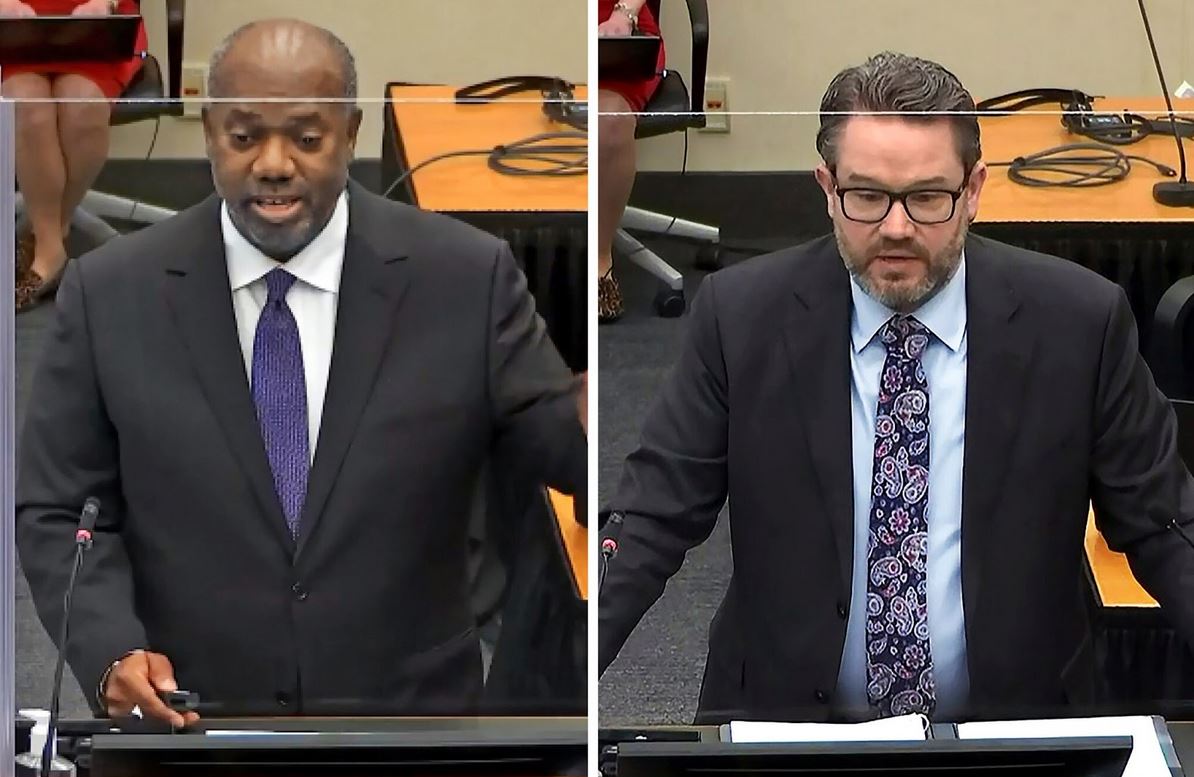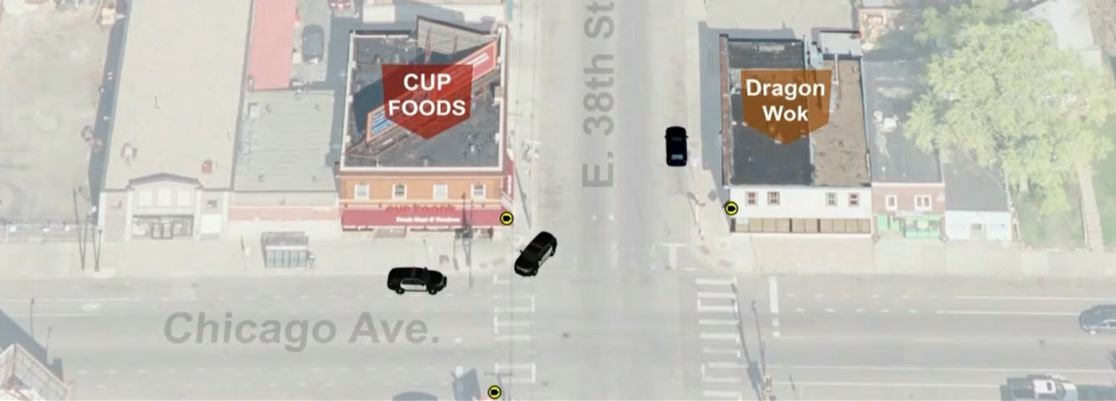The Derek Chauvin murder trial started with strong opening statements from both sides followed by three state witnesses.
While the prosecution’s presentation seemed glitzier and more rehearsed with catchy phrases and the help of PowerPoint and footage, defense attorney Eric Nelson appealed to “common sense and reason” without the help of visual aids.
Jerry W. Blackwell, one of the prosecutors in a team of at least 12, played the lengthy bystander video of Chauvin kneeling on George Floyd’s neck, noting repeatedly that Chauvin did not “let up or get up” for about nine minutes and 29 seconds. Chauvin is charged with third-degree murder, second-degree murder, and second-degree manslaughter in Floyd’s death.
Please follow Maryam Henein on Twitter
You can support her work on Patreon
Follow Maryam on Telegram and Gab
You may recall that the mainstream media repeatedly told the world that the duration of Chauvin on Floyd’s neck was 8:46. That time duration was disputed months ago despite it persisting in the media.
Not all agree that details make a difference.
“It makes no difference,” Jamar Nelson, who works with families of crime victims in Minneapolis, told the media in June, stating that 8:46 was symbolic and that was enough. “The bottom line is, it was long enough to kill him, long enough to execute him.”
Consider that words can distort and persuade.
Prosecution: Technology & Slogans To Seduce
Behind plexiglass, Blackwell, who admitted that Floyd suffered from drug addiction argued that Floyd died as a result of the excessive force of Chauvin pressing his knee on his neck during the arrest.
“You will learn that on May 25, 2020, Mr. Derek Chauvin betrayed this badge when he used excessive and unreasonable force upon the body of Mr. George Floyd. That he put his knee upon his neck and his back, grinding and crushing him until the very breath, no ladies and gentlemen until the very life was squeezed out of him.”
He showed the video that went viral where Floyd said “I can’t breathe,” repeatedly, a phrase that quickly became a motto for activists worldwide.
“You can believe your eyes, that it’s homicide — it’s murder,” insisted Blackwell.
For the record, Floyd said “I can’t breathe” seven times before Chauvin arrived at the scene. He said it a total of more than 20 times.
Blackwell indicated to jurors that in their view, Chauvin, who is 45 and 5’9, “betrayed his badge,” and used more force than reasonable, given that Floyd was handcuffed and on the ground.
“Here in this case you’ll hear that an autopsy didn’t see any objective things in George Floyd’s tissues … But you have to look at all the evidence to see what happened at the scene … all tell-tale signs of a person struggling and suffering from not receiving sufficient oxygen.”
Consider that the initial footage released by the media failed to show Floyd, who is 6’4 (there are different heights circulating) and 220 pounds, resisting officers.
Chauvin Defense: Floyd Put Meth and Fentanyl Pills In His Mouth To Hide From Officers
Chauvin’s lawyer, Eric J. Nelson, opening statements was 20 minutes long compared to the nearly one-hour address by the state. There were no bells or whistles just an appeal for rationale. Meanwhile, Chauvin copiously took notes nearby as he did during jury selection.
“Common sense is the application of sound judgment based upon a reasoned analysis. And that’s what this case is ultimately about. It’s about the evidence in this case…There is no political or social cause in this courtroom.”
He noted that there are more than 50,000 pieces of evidence in the case and that there was much more that happened than the length of time Chauvin knelt on Floyd’s neck.
“The evidence is far greater than 9 minutes and 29 seconds, you will learn in this courtroom that evidence has been gathered clearly and extensively.”
For starters, he informed the courtroom that Floyd was with Maurice when they arrived at Cup Foods, which is where they ran into Floyd’s ex, Shawanda Hill. Floyd reportedly used a counterfeit bill to pay for cigarettes. (Keep in mind that on Thomas Alexander Kueng’s body-worn camera, the owner of Cup Foods, Mahmoud Abumayyalah, tells him they both had counterfeit bills. How he knows that and whether this was investigated remained unclear.)
Cup Foods told police that the suspect was seen “on top” of the blue Mercedes, which was parked across the street for 20 to 30 minutes before police arrived.
“While they were in the car, Mr. Floyd consumed what were thought to be two Percocet pills,” Nelson said in his statement, revealing that his friends will later testify that “Mr. Floyd fell asleep in the car, and that they couldn’t wake him up.”
This prompted Shawanda to call her daughter, Shakira Prince, because they “couldn’t keep Mr. Floyd awake.”
Apparently, an employee went to the vehicle, and actually asked Floyd to come inside and use another bill or return the cigarettes, but Floyd refused. This precipitated the call to 911, and by 8:08 pm MPD police car 320 had arrived on the scene. It was also reported in the 911 call that Floyd was under the influence.
When confronted by police, “Mr. Floyd put drugs in his mouth in an effort to conceal them,” Nelson said. Floyd told both Officer King and Officer Lane that he was “on nothing” when confronted about his current state of intoxication.
Nelson added that surveillance videos from across the street show that there is evidence of “further concealment of controlled substances.”
In an arrest the year prior to his death, body-cam footage also shows him resisting and then swallowing pills during the arrest.
While Floyd’s friends stated the pills to be Percocet, search warrants executed on the Mercedes Benz on May 27th and December 9th last year produced various pieces of evidence during this search, including two pills.
Nelson has described the 2019 and 2020 incidents as “remarkably similar” and has argued that the previous arrest is relevant because of newly discovered evidence in the Chauvin case — including fragments of chewed-up pills containing methamphetamine and Floyd’s DNA that were discovered in a January search of the squad car into which Chauvin and the other three officers at the scene had attempted to put Floyd.
An autopsy later found fentanyl and methamphetamine — a narcotic concoction known as a “speedball” — in Floyd’s system.
Incidentally, aside from counterfeit cash circulating in Minnesota, there is also a counterfeit pill problem, but these bigger issues plaguing this was not mentioned.
Nelson, said the evidence will show that “Mr. Floyd died of cardiac arrhythmia that occurred as a result of hypertension, coronary disease, the ingestion of methamphetamine and fentanyl, and the adrenaline flowing through his body, all of which acted to further compromise an already compromised heart.”
“The state was not satisfied with Dr. Baker’s work, and so they have contracted with numerous physicians to contradict Dr. Baker’s findings,” Nelson said. “This will ultimately be another significant battle in this trial: What was Mr. Floyd’s actual cause of death?”
Hennepin Medical Examiner Andrew Baker had noted that had Floyd been found at his home, Floyd would have been classified as an overdose.
Blackwell rebuked the idea of an overdose, saying that Floyd didn’t die instantly, like one does of cardiac arrest, or nod off, such as in the instance of an opioid overdose.
Opioid overdose victims, he said, are “not screaming for their lives, they’re not calling for their mothers, they’re not saying ‘Please, please, I can’t breathe.’ That’s not what [an] opioid overdose looks like,” Blackwell said.
In closing, Nelson added that given Floyd’s resistance to police, Chauvin’s force was within the bounds of his training. Nelson said that there were no signs that Floyd was asphyxiated or that his airflow was restricted in any way. He added that the officers discussed handling procedures like the “hogtie technique,” which is used for a syndrome called “excited delirium.”
The mainstream media gave the impression that George Floyd’s nose was bleeding from pressure to his neck or loss of breath, but apparently, he had banged his face against the glass while in the police car.
Called To The Stand
123096 Dispatcher Jena Lee Scurry
The prosecutor’s first witness testimony came from a 911 dispatch operator for the City of Minneapolis. Jena Scurry ultimately “called the police on the police.”
Under questioning by prosecutor Matthew Frank, she said she was troubled by what she saw on the city surveillance cameras.
“My instincts were telling me that something was wrong. Something wasn’t right,” said Scurry who sometimes works taking calls rather than as a dispatcher. There were apparently two calls for emergency help within one minute.
She said she glanced up at the wall-mounted dispatch screens between taking other calls and saw a police squad moving “back and forth” as officers dealt with Floyd, then moments later take him to the pavement.
Scurry said officers pinned down George Floyd for so long she thought the camera feed “had frozen.” She then called the sergeant in charge of the officers, saying, she didn’t want to be a “snitch” before reporting what she was seeing.
The audio of that call was played in court:
“I don’t know, you can call me a snitch if you want to but we have the cameras up for [squad] 320’s call, and … I don’t know if they had to use force or not, but they got something out of the back of the squad, and all of them sat on this man, so I don’t know if they needed you or not, but they haven’t said anything to me yet.”
Under questioning by Nelson, she did agree that she could not hear what was happening at the intersection and does not have the same training as a police officer.
A Minneapolis Park Police officer did arrive on the scene. His body-cam video was released on May 27th but with black boxes and no sound. Defense alluded this would be played in court.
Alisha Oyler
The second witness was Alisha Oyler, 23, who worked at the Speedway station at the intersection. She says she shot seven videos of George Floyd’s arrest from across the street at Speedway because “police are always messing with people … and it’s not right.”
She often rubbed her head, batted her fake lashes, and said she couldn’t remember. At one point when asked whether she was outside, she answered “I think.”
Donald Williams
Donald Williams, 33, was the third witness for the case. He was walking around the Cup Food stores when he was drawn to the commotion. The bystander can be repeatedly heard saying ‘You’re a bum, bro. You’re a bum” on Darnella Frazier’s viral cellphone footage.
“The more you see Floyd fade away, slowly fades away, like a fish in a bag. You see his eyes slowly, you know, pale out,” William tells the court. “His eyes slowly rolled to the back of his head. You see blood coming out of his nose.”
Apparently, the mixed martial artist who testifies Chauvin put Floyd in a “blood choke” was also a BLM Rioter caught on camera vandalizing a cop car.
Who is Donald Williams? Mixed martial artist testifies Derek Chauvin held George Floyd in a "blood choke", causes likely mistrial that night with the following photograph of his felonious deeds. #ClownWorldNews https://t.co/fKtq6zhm5j pic.twitter.com/NoyLxAXFdN
— Alan Bings (@AlanBings) March 30, 2021
Day 13 resumes with Nelson questioning Williams, whose nickname is reportedly “The Deathwish.”
See the archive of the jury selection HERE.
Become a Patron!
Or support us at SubscribeStar
Donate cryptocurrency HERE
Subscribe to Activist Post for truth, peace, and freedom news. Follow us on Telegram, SoMee, HIVE, Flote, Minds, MeWe, Twitter, Gab and Ruqqus.
Provide, Protect and Profit from what’s coming! Get a free issue of Counter Markets today.



Be the first to comment on "Opening Statements Commence in Derek Chauvin Murder Trial — Partially Dissolved Pills, 9:29, And Percocet Discussed"